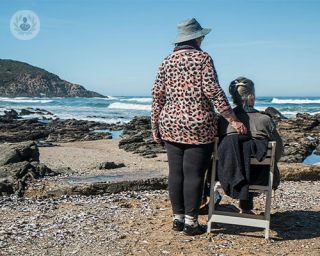Polymyalgia rheumatica (PMR)
Dr Gagandeep Kaur Takhar - Rheumatology
Created on: 11-13-2012
Updated on: 04-18-2023
Edited by: Conor Dunworth
What is polymyalgia rheumatica?
Polymyalgia rheumatica, often called PMR, is an inflammatory disease which causes pain, stiffness and limited mobility in the neck, shoulders, arms, hips, torso, pelvic girdle and thighs. It is unknown what causes the condition to develop but is mostly suffered by women over fifty.

What is the prognosis for polymyalgia rheumatica?
Although medication can provide relief from symptoms, sometimes patients are unable to complete their usual daily activities as before and may need the help of a family member at home. Fortunately, for most people, PMR disappears after one to two years of treatment.
What are the symptoms of polymyalgia rheumatica?
Pain and stiffness in the shoulders and neck are the main symptoms of this disease and discomfort in the hip is also commonly experienced. The pain does not cause swelling and appears after rest, usually at night.
Inactivity, such as a long car trip or sitting in the same position for a long time, can cause stiffness to return. In addition, it is very common for patients to have problems raising their upper arms above their shoulders. Fatigue can be another characteristic symptom. People suffering from this disease have more and more difficulty getting out of bed and starting their daily activities.
Other symptoms include:
- Hair loss that occurs because of a loss of appetite
- Depression
- Fever
How is polymyalgia rheumatic diagnosed?
Most patients suffering from this disease have high markers of inflammation, a high erythrocyte sedimentation rate and a high level of C-reactive protein, which can be determined in some laboratory. Other markers for this condition include:
- Abnormal levels of blood proteins
- An abnormal white blood cell count
- Anaemia (low blood count)
What are the causes of polymyalgia rheumatica?
The cause of the disease is unknown but it usually develops in people over fifty years of age, with most diagnoses being made in patients over seventy. One of the diseases that can trigger PMR is temporal arteritis, a condition in which the blood vessels that carry blood to the head and the eyes become inflamed. Sometimes it is difficult to diagnose PMR and it can often be confused with rheumatoid arthritis in an older person.

Can polymyalgia rheumatica be prevented?
There is currently no form of prevention of polymyalgia rheumatica, mostly because there are no clear, direct causes of the condition. It is believed that a combination of genetic and environmental factors can predispose a person to polymyalgia rheumatica.
How is polymyalgia rheumatica treated?
The most effective treatment for PMR is low dose corticosteroids. Small amounts can relieve symptoms in one or two days. The dose can be slowly reduced over time. It is necessary to continue with treatment for one to two years and longer in some patients. The corticosteroids may cause a wide range of side effects, so regular check-ups are necessary to monitor these effects.
Does polymyalgia rheumatica always require treatment?
Without treatment, the symptoms of polymyalgia rheumatica can worsen and seriously affect mobility, making daily activities such as dressing or getting in and out of a car difficult. In particular, patients may have trouble raising their arms above the head.
What type of doctor treats polymyalgia rheumatica?
Specialist rheumatologists treat polymyalgia rheumatica.















